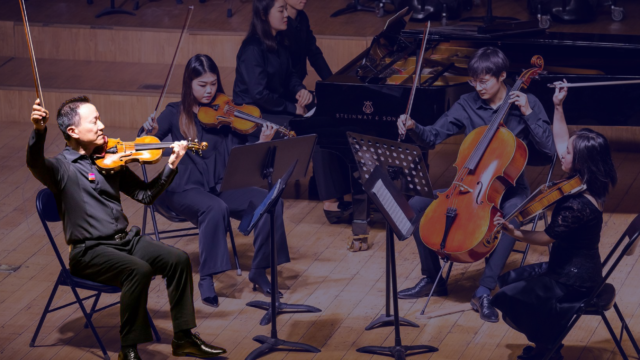Key Findings | Diversity in the Orchestra Field 2023
Musicians
- Black or African American, Hispanic/Latinx, Native Hawaiian and Other Pacific Islander, and American Indian and Alaska Native representation is significantly lower among orchestra musicians than in the U.S. population overall.
- Continuing a longstanding trend, Black or African American musician representation improved at a slower rate than that of any other racial/ethnic group, increasing only very slightly during the ten-year period.
- The proportion of Asian or Asian American people working as orchestra musicians remains higher than in the overall U.S. population and is higher than that of all other BIPOC groups combined.
- The proportion of Asian or Asian American musicians remains highest in larger budget orchestras, while the representation of Black or African American, Hispanic/Latinx, and Multiracial musicians remains highest in smaller-to-medium budget orchestras.
- Near parity in men’s and women’s representation was maintained throughout the ten-year period, but women musicians were more likely to be working in smaller-to-medium budget orchestras than in larger budget orchestras.
Conductors, Including Assistant Conductors and Music Directors
- While BIPOC representation still lags well behind the U.S. population, it is now stronger here among conductors, including assistant conductors and music directors, than in any other orchestra role, having nearly doubled overall and accelerated during the pandemic years to reach close to one in three.
- This growth was largely driven by a doubling in the representation of Asian or Asian American people, who are now almost twice as well represented in this group as in the U.S. population overall. Black or African American and Hispanic/Latinx representation lags well behind the U.S. population, despite moderate increases.
- Fewer than one in four conductors, including assistant conductors and music directors, are women despite strong growth in representation compared to other orchestra roles during the ten-year period.
Music Directors
- BIPOC representation among music directors improved slowly overall, but more rapidly in larger budget orchestras than in smaller-to-medium budget orchestras. In 2023, roughly one in four music directors are BIPOC.
- Growth was mainly driven by a strong increase in the representation of Asian or Asian American music directors within larger budget orchestras. In 2023, Asian or Asian American people are better represented in the music director population than in the U.S. population as a whole.
- Hispanic/Latinx music director representation also increased, resulting in higher representation here than in other orchestra roles.
- Black or African American and Multiracial representation among music directors decreased between 2013-14 and 2022-23.
- Only one in nine music directors are women. The percentage of women in larger budget orchestra music director roles fell from one in nine to one in 18.
Staff Members, Including Top Executives
- The proportion of women, nonbinary, and Black or African American people is higher among staff than in any other role.
- BIPOC representation increased moderately overall. From a relatively low starting point in 2014, BIPOC representation among orchestra staff increased to reach roughly one in five.
- This moderate growth was driven by a strong increase in Black or African American representation during the pandemic years. As a result, the proportion of Black or African American people is now higher among staff than in any other orchestra role.
- The proportion of Asian or Asian American staff members barely increased during the ten-year period, and Asian or Asian American people continue to be less well-represented among orchestra staff than in other orchestra roles.
- Nonbinary representation increased and is now higher among staff than in any other orchestra role.
Top Executives
- The proportion of BIPOC, women, and nonbinary people remains much lower among top executives than within orchestra staff.
- At fewer than one in nine, the proportion of BIPOC people in top executive positions remains considerably lower than in other orchestra roles, despite strong growth during the ten-year period.
- BIPOC growth was mainly driven by strong increases in Hispanic/Latinx and Multiracial representation, coupled with more moderate growth, from a higher starting point, among Asian or Asian American representation.
- Women’s representation in top executive roles still lags far behind the wider nonprofit sector (despite increasing overall) and is focused within smaller-to-medium budget orchestras.
- No nonbinary top executives were reported.
Board Members
- Orchestra boards remain significantly less racially/ethnically diverse than the boards of nonprofit organizations overall, themselves acknowledged as poorly representative of the U.S. population. Hispanic/Latinx representation remains especially low in comparison with the overall U.S. population.
- From a standing start, board racial/ethnic diversity began to improve in the 2013-14 season, largely driven by new Black or African American board members, and more than doubled by the 2022-23 season.
- However, the low starting point meant that still only one in six orchestra board members identify as BIPOC.
- Men remain better represented than women on the boards of larger budget orchestras.
- No nonbinary board members were reported.
Jump to another page:
- Introduction
- Overall Findings
- Key Findings
- Recommendations
- Definitions
- Technical Notes
- Detailed Analysis 1: By Orchestra Role (see full PDF)
- Detailed Analysis 2: By Demographic Group (see full PDF)
- Detailed Analysis 3: By Role and Budget Size (see full PDF)
- Detailed Analysis 4: Focus on the Pandemic Years (see full PDF)
- Appendix 1: Methodology
- Appendix 2: Stories of Progress in Orchestras
- Appendix 3: References
- Acknowledgements
This project was supported in part by an award from the Research Grants in the Arts program at the National Endowment for the Arts, Grant #1863433-38-20. Additional funding was provided by a generous grant from the Mellon Foundation, and by public funds from the New York City Department of Cultural Affairs in partnership with the City Council.
Related
-
Learn | Audience Engagement
Shaping a Positive Musical Learning Environment for Youth
Become a member
Thank you for your interest in the League of American Orchestras! We are dedicated to advancing the orchestral experience for all.
Join Now


